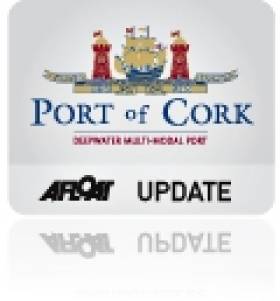Displaying items by tag: Sea Bed Ploughing
Port of Cork Records Sea Bed Ploughing with Ground Breaking 'Succorfish' Technology
#portofcork – A project that has allowed the Port of Cork to precisely monitor and record the winter program of seabed ploughing in real time for the first ever time is being delivered by Succorfish in partnership with Irish marine communication specialists SEA-Tech.
The groundbreaking exercise, which is being carried out aboard a utility vessel working to lift sediment from the port seabed into the water column and back out to sea, sees live, up-to-the-minute and highly valuable location data transferred back to officials instantly in real time. And, given its success, it is anticipated that it could change the way future ploughing operations are carried out as well as greatly improve efficiency for the world's second largest natural harbour.
Succorfish, a leading provider of intelligent M2M data transfer technology, next generation telematic communication systems and GSM/GPRS asset tracking products, has installed its SC2 vessel monitoring unit and RFID winch sensors aboard MV Denis Murphy, a 20m multi-cat utility vessel used for maintenance duties including bed leveling and oil pollution response.
Over the next six months, Port of Cork and SEA-Tech personnel will have the ability to accurately record vessel movement more frequently and in real time, and analyse activity as it happens from specfic harbour areas using the system's innovative 'geofence' facility.
Succorfish Head of Marine, Tom Rossiter, explained, "This project builds on the success working with Welsh scallop fishermen in Cardigan Bay and by partnering with SEA-tech in Ireland, we can demonstrate how the SC2 is becoming an integral piece of equipment for vessel operators whether they be skippers, fleet managers or marine authorities.
"The Port of Cork project is significant as the technology used has the potential to change operational methods and increase efficiency here and at similar ports worldwide. Never before has activities such as ploughing been accurately mapped onshore at the same time as the activity is being carried out on the vessel and this will be beneficial for future planning as well as day to day operations of the port.
Our technology provides the most up to date information from remote areas of the business in an accessible and cost effective manner."
The SC2 monitoring unit uses state of the art GPRS/GSM technology, Iridium satellite reporting as well as bespoke online software to offer the marine industry a complete low cost solution. It includes sector specific features including e-log data reporting, SOS emergency alarm, anti hijack alert, radio frequency identification (RFID), crew safety systems and also deep sea thermal sensor attachments for fishing gears.
The system installed aboard the MV Denis Murphy also offers 100% data security and allows users to access their own information via a password protected online interface.
Critically, and as well as Iridium satellite reporting, this information is available via mobile devices allowing users to monitor progress whilst on the move. The RFID scanner fitted to the heavy duty winches also demonstrates the SC2's ability to monitor activity remotely across all areas of the vessel's operations.
Another proven feature is the geofence facility that manages access to certain areas and alerts the operator by email or text whenever a vessel enters or exits such waters. It is currently used successfully by fishery managers in the UK to monitor marine protected areas to two metres accuracy and gives operators an exceptional level of confidence in knowing the exact location of their vessel at any given time.
Arnaud Disant, Owner of SEA-Tech added, "Information gained from this exercise will be of significant value to both ourselves as specialist marine consultants as well as the Port of Cork as end users. From evidence obtained so far the opportunities that it presents are very encouraging and could have a long lasting effect on how port operators carry out commercial and operational activities both in Ireland and worldwide."




























































